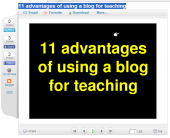Bede Poems
Poems about local heritage is a great example of how to use free blogging software to just get some content quickly on to the web for your audience to access.
Three GTP teachers, at Bede Academy in Blyth, have worked together on this project, taking photos, shooting video and recording audio to present. Sadly the free account offered by wordpress.com does not allow for the upload of audio or video (although it is relatively inexpensive to upgrade).
The wordpress.com account was set up and the first poem typed up in minutes. The selection of a pre-built theme ensured that everything is presented nicely. Given that the blog was designed for students to read, the trainee teachers had to consider what sort of content students might be able to get to from the wordpress blog. They also had to consider whether to allow comments to be made and whether comments could be previewed and filtered prior to publication.
This is exactly the type of resource that could easily be created and published on Bede Academy’s (Emmanuel Schools Foundation’s) forthcoming Compass VLE system.
Filed under: Uncategorized | Leave a Comment
Why blog?
 11 advantages of using a blog for teaching is a nicely presented (on-line slideshow) analysis on not only advantages, but also the concerns related to blogging in education. I’m not a fan of some of the charts and diagrams (infographics as they are often referred to on the web these days), but the main points are well made.
11 advantages of using a blog for teaching is a nicely presented (on-line slideshow) analysis on not only advantages, but also the concerns related to blogging in education. I’m not a fan of some of the charts and diagrams (infographics as they are often referred to on the web these days), but the main points are well made.
Filed under: Uncategorized | Leave a Comment
Primary Blogger
Yet another blogging platform for school children, this time aimed at primary schools. Yet to be further investigated. I really like the video page: http://demo.primaryblogger.co.uk/. It’s got some great ideas form primary schools and mentions several free media manipulation tools.
Filed under: Uncategorized | Leave a Comment
Junior School Blogging
Sudley Junior School does have a website with a homepage and links to photos and video. However, it’s their blogging site that is really engaging and alive. There are blogs for each year group, blogs with school information and blogs on topics of interest. I can see, from the dates of the posts, that the site is up to date whilst comments tell me that there’s an engaged audience. This site seems fresh, inviting and useful compared to the standard school website of most other small schools.
It also highlights the way that blogging platforms can be used to, very easily, create website content, in a format that natively encourages engagement and interaction.
Filed under: Uncategorized | Leave a Comment
Writing for an audience using blogs is a case study I found interesting on the BECTA website.
I particularly liked:
- The section suggesting five steps in getting a student group started with blogging.
- The Barriers and Enablers section.
In addition, it has highlighted Edublogs as another blogging platform to investigate.
Filed under: Uncategorized | Leave a Comment
Blogging Platforms
The Compass VLE system (Blackboard) supports blogging within its framework of courses (classes) and organisations (clubs, societies and groups). Generally, there are a wealth of blogging tools available on the web. Some tools are installable applications which you launch from your computer. Most of these, require you to register a domain name (a web site name) of your own to publish to. Alternatively there are many other blogging tools that allow you to create a blog online, by simply visiting a web page, and also post (host) your blog(s) for you. This blog has been created using WordPress, found at www.wordpress.com, that allows you to set up and manage blogs and actually hosts them for you.
Seven Blogging Tools Reviewed is a page doing exactly what it says on the tin. It includes this useful comparison chart on the pros and cons of the tools reviewed:
Filed under: Blogging Tools | Leave a Comment
What is a blog?
You are currently reading an entry in a web-log (blog)
A blog is basically a journal that is available on the web. The activity of updating a blog is “blogging” and someone who keeps a blog is a “blogger.” Blogs are typically updated daily using software that allows people with little or no technical background to update and maintain the blog. Postings on a blog are almost always arranged in chronological order with the most recent additions featured most prominantly.
Filed under: Getting Started | Leave a Comment
Blogs can be created that are either individual or course (class) based.
In a course based blog, anyone enrolled on a course can see all of the posts to a blog together and post to the blog. Anyone enrolled on a course can also add comments to posts.
In an individual blog, each user has there own blog, which only they can post to. Other users can vew the blog and post comments. The blogs are accessible from a menu that lists the users with blogs.
Filed under: Compass VLE | Leave a Comment


